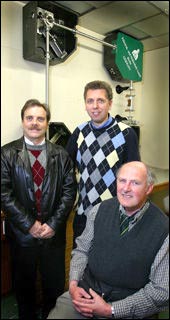Lynette Hartley Reprinted from the University of Canterbury’s Chronicle – 13/10/03
The southern wall of the photocopy room in the Physics and Astronomy Department is about to become one of the most studied walls in the University of Canterbury in Christchurch.
Over the next few weeks, a 1.6m by 1.6m ring laser, weighing more than 400kg, will be mounted on the seventh floor wall.
The ring laser, called PR1, is the fourth the department has produced in collaboration with a team from the Technical University of Munich. Ulrich Schreiber, who is employed by the university in Munich, but who is also an Adjunct Professor at Canterbury, says PR1 has been set up to test a novel application for ring laser technology – as a civil engineering tool.
|
|
| Professors John Mander (left), Ulrich Schreiber and Geoff Stedman hope the new ring laser will provide more information about the way buildings behave in earthquakes. |
Ring lasers measure, very precisely, whether a plane is rotating in space. They do this by measuring the time taken for two red laser beams to travel in opposite directions around, in this case, a square. Precisely adjusted mirrors at each corner of the square direct the lasers on to the next mirror and, eventually, back to the start. The two laser beams travel at a constant speed (the speed of light) through the near vacuum in the tubes connecting the four mirrors. If the square of mirrors is rotating in space, for example as the earth rotates, the two beams going in opposite directions around the square will reach the start point at different times because they have travelled different distances.
Professor Schreiber says the Physics and Astronomy Department at Canterbury pioneered work on ring lasers in the 1980s and it was the first in the world to produce a functional large ring laser.
The Munich team, meanwhile, was studying tiny variations in the earth’s rotation. While the earth’s rotation is very regular and predictable, tiny variations can be introduced by movements in water masses, like the changes associated with El Nino, or movements of magma in the interior of the Earth.
The Munich team approached the Physics and Astronomy Department after its success in producing the working large ring laser. The two teams have been collaborating ever since and have produced a series of increasingly sophisticated ring lasers for use in Germany and Canterbury.
The ring lasers are made in Germany and most have been installed in the Cashmere Cavern in Christchurch. The cavern was blasted into the Port Hills during the Second World War. It is an ideal place for research on ring lasers, Professor Schreiber says, because the temperature and the foundations are so stable. An old cave is much better than a freshly blasted one because it takes decades for the rock to restabilise.
“Our forefathers built a laboratory that was just right by the time we required it,” Professor Schreiber jokes.
The lasers have been used to investigate variations in the earth’s rotation but in recent years the team has turned its attention to earthquakes. PR1 is a joint project with the Civil Engineering Department.
Professor John Mander says ring lasers have the potential to provide a lot of new information about the way buildings behave in earthquakes. Traditional seismographs record straight-line movements, for example shaking, whereas ring lasers measure rotational movements like rolling or twisting.
Up until now it has not been possible to measure how much rotation is happening in a building in an earthquake, Professor Mander says, but these movements can, potentially, cause significant damage.
The advantage of using the Rutherford building for this series of experiments is that the team will not need to wait for an earthquake to see if the ring laser is working. PR1 should be sensitive enough to detect the movements caused by strong gusts of wind hitting the building and the daily movements in the building as the sun crosses from the long east face to the long west face on sunny days, Professor Mander says.
Professor Schreiber says one of the first hurdles for the team to overcome will be measurement inaccuracies caused by temperature changes in the photocopy room.
“It is an adventure. We have no idea how well instruments like this work in a place like this. Temperatures go up and down by a vast amount and ring lasers do not like that. But this is the way research is done. You start off from principles and you get ideas and it gets to the point when you say, ‘let’s try it out’,” Professor Schreiber says.





